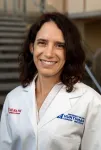(Press-News.org) URBANA, Ill. – Raw poultry is one of the main causes of Salmonella poisoning, which affects thousands of people in the U.S. every year. A new study from the University of Illinois Urbana-Champaign shows that few products with high levels of very virulent Salmonella strains are responsible for most of the illnesses from raw chicken parts. The researchers suggest regulation efforts should focus on detecting and preventing those types of high-risk contamination.
“Over the last 20 years, the poultry industry has done a really good job of lowering the frequency of Salmonella in poultry. However, the number of people who are getting sick from these pathogens hasn’t declined. The U.S. Department of Agriculture is considering changes to how they regulate Salmonella based on level and serotype, and our research supports those efforts,” said study co-author Matt Stasiewicz, an associate professor in the Department of Food Science and Human Nutrition (FSHN), part of the College of Agricultural, Consumer and Environmental Sciences (ACES) at Illinois.
There are over 2,600 serotypes, or sub-groups, of Salmonella bacteria and they differ in their capacity to make people sick. Salmonella Kentucky is one of the most common serotypes in U.S. chicken, but it is less likely to cause human illnesses compared with three more virulent strains linked to multiple outbreaks of salmonellosis.
The researchers wanted to assess the public health risk from Salmonella contamination of chicken parts, comparing the impact of high- and low-virulence serotypes at different levels.
“We applied a mathematical method called Quantitative Microbial Risk Assessment, using datasets on contamination from the USDA Food Safety and Inspection Service as input. We set different levels and serotype thresholds to estimate the risk of getting ill from each of them,” explained lead author Minho Kim. He conducted the study as a doctoral student in FSHN, and now works as a postdoctoral research fellow with the USDA Agricultural Research Service.
The baseline calculations yielded an estimate of about two salmonellosis cases per 1 million servings of chicken consumed. In all the scenarios, risk was concentrated in a few products with high levels of highly virulent serotypes. Less than 1% of illnesses were attributed to Salmonella Kentucky, while 69% to 83% of illnesses were attributed to products with high levels of Enteritidis, Infantis, or Typhimurium serotypes. These findings are consistent with what seems likely to be the proposed changes in regulations, the researchers stated.
The next step is to figure out how to specifically target those virulent strains. Kim and Stasiewicz suggest possible approaches such as using statistical processing control to monitor Salmonella, a test-and-hold procedure for batches of products, or vaccinating chickens against the high-virulence serotypes.
However, they emphasize that their research focuses on estimating the risk, and it is up to the poultry industry — which knows best how to improve its processes — to find strategies to manage it.
“Our research helps to align regulations with public health, and then the industry will figure out the right way to do it,” Stasiewicz said. “These findings support the USDA’s initiative to shift regulation towards high-level, high-risk contamination events rather than frequency of detection. I hope this will help consumers understand it's a good strategy that’s designed to protect public health. The layperson could think the new regulations are letting the industry off the hook, because they only target specific pathogens and allow contaminated chicken to get through production. But it makes sense to focus on the strains that are actually making people sick.”
Stasiewicz said you can think of it as a three-step process: the science shows where the risk is, the government sets the regulatory policy, and the industry figures out how to manage risk reduction.
The researchers stressed that consumers should still follow food safety guidelines when preparing poultry, such as washing their hands, avoiding cross-contamination, and ensuring the meat is properly cooked.
The paper, “Risk Assessment Predicts Most of the Salmonellosis Risk in Raw Chicken Parts is Concentrated in Those Few Products with High Levels of High-Virulence Serotypes of Salmonella,” is published in the Journal of Food Protection [DOI: 10.1016/j.jfp.2024.100304]. This study was supported by a US Poultry and Egg Association grant.
END
Most Salmonella illnesses from chicken caused by few products with high levels of virulent strains
2024-07-15
ELSE PRESS RELEASES FROM THIS DATE:
Kenyan crop contamination outbreak inspires grad student to improve rice storage
2024-07-15
By Maddie Johnson
University of Arkansas System Division of Agriculture
Arkansas Agricultural Experiment Station
FAYETTEVILLE, Ark. — While half the global population relies on rice as a staple, about 15 percent of rice produced each year is contaminated by potentially fatal aflatoxins. Seeing this threaten lives in her home country of Kenya prompted a graduate research assistant to focus on eradicating the risk through safer storage methods.
Faith Ouma, a Ph.D. student in the food science department at the University of Arkansas, was the lead author of “Investigating safe storage conditions to mitigate aflatoxin contamination in rice.” It was published ...
Survey finds women in their 40s may choose to delay mammography when informed about the benefits and harms
2024-07-15
Embargoed for release until 5:00 p.m. ET on Monday 15 July 2024
Annals of Internal Medicine Tip Sheet
@Annalsofim
Below please find summaries of new articles that will be published in the next issue of Annals of Internal Medicine. The summaries are not intended to substitute for the full articles as a source of information. This information is under strict embargo and by taking it into possession, media representatives are committing to the terms of the embargo not only on their own behalf, but also on behalf of the organization they represent.
----------------------------
1. ...
CDI scientists ID ‘unconventional’ new pathway for TB vaccines
2024-07-15
An “unconventional” immune response now identified by scientists from the Hackensack Meridian Center for Discovery and Innovation (CDI) is a potential new pathway for developing new vaccines for tuberculosis (TB), according to a new publication.
Marginal zone B (MZB) cells are a natural response to TB infection which has been long overlooked - and which might be a welcome new target that could be bolstered through new vaccines to better combat and prevent the disease, according to the new publication in the journal Cell Reports.
“Our results indicate that B cells skew their immune landscape ...
Mendoza, Weiss receive $2.6 million grant to study biomechanics of lung tumors
2024-07-15
Michelle Mendoza, PhD, researcher at Huntsman Cancer Institute and associate professor of oncological sciences at the University of Utah (the U) and Jeffrey Weiss, PhD, professor of biomedical engineering and faculty member in the Scientific Computing and Imaging Institute at the U, are the recipients of a $2.6 million grant from the National Institutes of Health (NIH) to research how tension in lung tissue affects the growth and distribution of tumors. This innovative approach could uncover new mechanisms for understanding how lung cancer develops.
“There ...
Study shows how narcissistic CEOs influence the board of directors to take more risk
2024-07-15
Narcissistic CEOs that also serve as chair of the board are adept at controlling how their boards of directors focus their attention, giving the CEO the ability to get their way. A new study published in the Strategic Management Journal found that by driving board discussions about risk-taking to hold a positive tone, narcissistic CEOs can allocate more resources toward risk-taking strategies. The findings deepen our understanding of how CEO behavior and personality types can drive risk management strategies.
The research team — Christopher S. Tuggle of the University of Central Arkansas, Cameron J. Borgholthaus of the University of Wyoming, Peter D. Harms of the University of Alabama, ...
Study shows timely transition from pediatric to adult care is critical for young adults with sickle cell disease
2024-07-15
Sickle cell disease is the most common inherited red blood cell disorder in the United States and can lead to health problems including organ dysfunction, acute chest syndrome and strokes over a patient’s lifespan. According to a new study, individuals living with sickle cell disease who experience a delay of more than six months after transferring from pediatric to adult care are twice as likely to be hospitalized compared to those who transition in less than two months.
In the study, Kristen ...
University of Cincinnati study: Long-term stroke survival improving, but racial disparities remain
2024-07-15
Overall rates of long-term survival following stroke are improving, but Black individuals experience worse long-term outcomes compared to white individuals, according to University of Cincinnati research published online July 15 in Neurology®, the medical journal of the American Academy of Neurology.
UC’s David Robinson, MD, corresponding author on the research, said prior studies had examined short-term stroke outcomes of 30 or 60 days, but this time the team looked at survival rates five years past a person’s stroke.
“This was ...
National Institutes of Health grant could mean progress toward improved outcomes for stroke patients
2024-07-15
The Associate Dean of Research at the University of Tennessee Health Science Center’s College of Nursing has received a two-year, $421,188 grant from the National Institutes of Health (NIH) to improve cognitive screening in people who suffer from a devastating type of stroke called aneurysmal subarachnoid hemorrhage (aSAH).
Professor Ansley Stanfill, PhD, RN, FAAN, has devoted her program of research to improving outcomes for people who survive strokes. Her latest grant aims to determine if an existing screening tool can be used in a new way to assess patients following aSAH and trigger a ...
SfN establishes James L. Roberts Endowed Fund
2024-07-15
Washington, D.C. – The Society for Neuroscience (SfN) has received $128,000 from the estate of James L. Roberts, PhD. With the funds, SfN Council voted to create a new long-term endowed fund, The James L. Roberts Fund, and will use the income from its investments to create and perpetually fund James L. Roberts Trainee Professional Development Awards (TPDAs) beginning at Neuroscience 2024.
“I knew Jimmy Roberts very well. We basically launched neurobiology at Sinai when we co-directed the Fishberg Research Center for Neurobiology at Mount Sinai from 1989–2002,” said incoming SfN President John Morrison. “Jimmy was an outstanding ...
Unlocking the mystery of preexisting drug resistance: New study sheds light on cancer evolution
2024-07-15
CLEVELAND—The evolution of resistance to diseases, from infectious illnesses to cancers, poses a formidable challenge.
Despite the expectation that resistance-conferring mutations would dwindle in the absence of treatment due to a reduced growth rate, preexisting resistance is pervasive across diseases that evolve—like cancer and pathogens—defying conventional wisdom.
In cancer, it is well known that small numbers of drug-resistant cells likely exist in tumors even before they’re treated. In something of a paradox, before treatment, these mutants have been repeatedly shown to have lower fitness than the surrounding ancestor cells from which they arose. It leads ...





